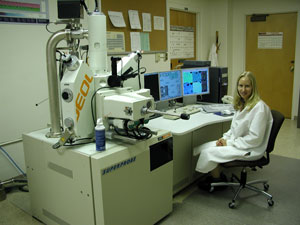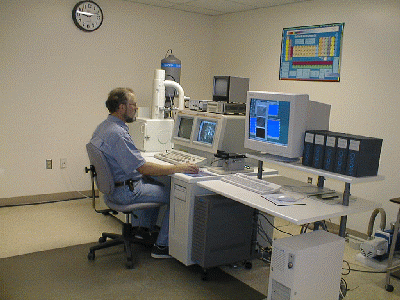INSTRUMENTATION
JEOL 8200 Electron Probe Microanalyzer

The Electron Microprobe (EMP) laboratory houses a JEOL 8200 microprobe, installed in Spring 2003. The probe is equipped with 5 wavelength dispersive (WD) spectrometers and an ultrathin-window energy dispersive spectrometer. The WD spectrometers are fitted with multiple analyzing crystals to provide quantitative analysis of all elements from Be to U. Two spectrometers are high sensitivity detectors and one spectrometer has a large PET crystal suitable for precise measurement of Pb, Th, U at low concentrations. In addition, a LaB6 gun provides superior spot resolution for imaging and analysis of small particles. Instrument vacuum is achieved using a turbomolecular pump backed by a scroll pump, and thus, the system is completely dry pumped to reduce contamination during long analyses, making it an ideal system for both major and trace element investigation and analysis of light elements. A powerful Sun Blade 2000 graphics workstation controls the fully automated system and can provide high resolution and high sensitivity X-ray maps over entire thin sections in order to find small, widely scattered analysis targets.
JEOL 5800LV Scanning Electron Microscope

The scanning electron microscope laboratory (SEM) contains a JEOL 5800LV SEM, equipped with secondary and backscattered electron and cathodoluminscence (CL) imaging detectors. The instrument is a low pressure microscope that can operate at both high and low vacuum. The low vacuum mode allows imaging and analysis of samples that do not have to be dried and coated before hand. This is particularly useful for handling wet samples such as soil, sandstone, and clay. An Oxford Analytical ultrathin-window EDS and an Oxford Isis 300 X-ray analyzer are attached to the microscope. The stage can accomodate specimens up to 6 inches (15.2 cm) across and has 5 motorized axes with full control from the Oxford computer for automated analyses. The analytical software provides semi- to fully quantitative EDS analysis down to boron, along with high resolution image acquisition, processing, and analysis. Advanced software capabilities of the Isis include phase distribution analysis based on chemical data from the EDS coupled with image data. The CL detector uses a parabolic-mirror light collecting element connected to a high-sensitivity photomultiplier tube, which provides good spectral response across the visible range into the near UV and IF.